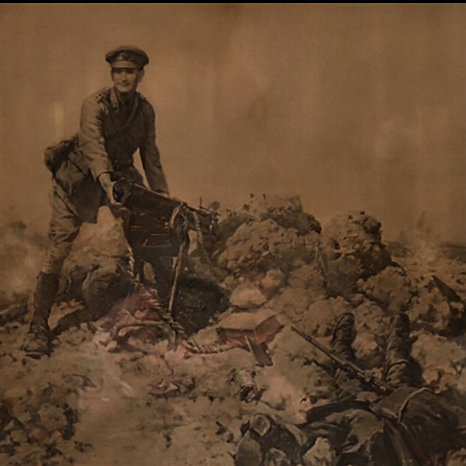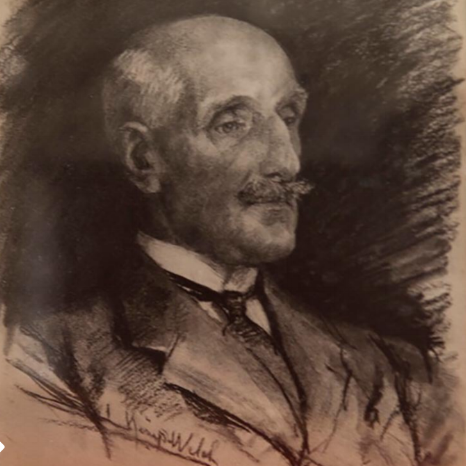Lucy Kemp-Welch is one of our finest equine artists and her work much sought after by both collectors and horse lovers. She was refused permission to travel to the battle fields of WW1 but such was her determination she found other ways to become a self imposed unofficial war artist.
One of her most moving tributes to the brave men that fell in action was to honour the deeds of Captain Elidyr Herbert Victoria Cross who fell in action on 12th November 1917. He was described by one of his men as ‘one of the most popular officers in the brigade’, who was ‘sincerely mourned’. Captain Herbert was buried in Gaza City military cemetery. His headstone bears Latin inscriptions meaning ‘The inn of a pilgrim travelling to Jerusalem’ and ‘Eternal rest grant unto him oh Lord’.
His death was widely mourned in Monmouthshire and in 1923 tenants from the Herbert Estates presented his parents, Lord and Lady Treowen with a painting by Lucy Kemp-Welch showing Captain Herbert with the Turkish machine gun. His family gave over part of the Llanover estate for a ‘garden settlement’, Tre Elidyr, in memory of their son and the 17 other men connected with the estate who lost their lives in the Great War.
So Tre Elidyr was built in 1925 with Llanover Primary School at its heart.
Captain Herbert was the son of Sir Ivor Herbert, who had recently been elevated to the Peerage as Lord Treowen. Until joining the House of Lords he had been Liberal MP for South Monmouthshire and, as Lord Lieutenant of Monmouthshire, had been responsible for recruiting throughout the county at the start of the war. He later became director of recruiting for the whole of Wales.
Elidyr was born in 1881. He went to King’s College, Cambridge, graduating in 1902. After qualifying as a solicitor he returned to Monmouthshire, living with his parents at Llanarth Court. He served as a Justice of the Peace and became a County Councillor.
In 1913 he joined the Royal Gloucestershire Hussars (RGH), part of the Territorial Force. When war broke out in 1914, as a 2nd Lieutenant, he summoned the Monmouthshire Squadron of the RGH to Llanover for mobilisation.
In April 1915 the RGH were sent to Egypt and subsequently to Gallipoli, landing at Suvla Bay, where he served as machine gun officer. They remained in Gallipoli until the campaign was abandoned in November and suffered heavy losses. After a brief spell in Egypt, where Lieutenant Herbert was promoted to Captain, he was sent with the RGH to the Sinai Desert and thence into Palestine.
As the British forces advanced through Palestine towards Jerusalem, they met fierce resistance from Turkish troops
Third Battle of Gaza which was part of the Sinai and Palestine campaign. Here the Egyptian Expeditionary Force (EEF) pursued the Turks and their allies through Southern Palestine and eventually captured Jerusalem a month later.
By November 1917, Elidyr Herbert saw action at about nine miles north-east of Gaza where he would show great bravery but which was to prove fateful for him.
The Charge at Huj (8 November 1917), saw the forces of the EEF made up of British and Australian forces, face the Ottoman Turkish Empire’s Yildirim Army Group.
The charge was carried out by units of the 5th Mounted Brigade, against a German, Austrian and Turkish artillery and infantry. The attack was successful and the British captured the position, seventy prisoners, eleven pieces of artillery and four machine guns. But the British suffered heavy casualties. Of the 170 men taking part, twenty-six were killed and forty wounded. They also had 100 horses killed. One can not help wondering if the fact that it was a mounted brigade and that so many horses we lost would have influenced Lucy Kemp-Welch to take on this commission .
One of the few officers to escape uninjured was Lieutenant Mercer of the Worcestershire Yeomanry. He described the charge:
“Machine guns and rifles opened up on us the moment we topped the rise behind which we had formed up. I remember thinking that the sound of crackling bullets was just like hailstorm on an iron-roofed building, so you may guess what the fusillade was....A whole heap of men and horses went down twenty or thirty yards from the muzzles of the guns. The squadron broke into a few scattered horsemen at the guns and seemed to melt away completely. For a time I, at any rate, had the impression that I was the only man left alive. I was amazed to discover we were the victors”.
The action is claimed to be one of the last British cavalry charges and was pictured in a watercolour painting by the British artist by Elizabeth Southerden Thompson.
After a Turkish counter attack had been repelled Captain Herbert, noticing that the Turks were regrouping and preparing to attack again, rushed forward ahead of his men to grab an abandoned Turkish machine gun and turn it on the enemy. It is this act of bravery that Kemp-Welch captures in her finished oil painting . We currently have the preliminary charcoal drawing for this oil and it if for sale here in Hertfordshire with Blondes Fine Art.
Charcoal drawing for oil painting available for sale . Please ask for details.


